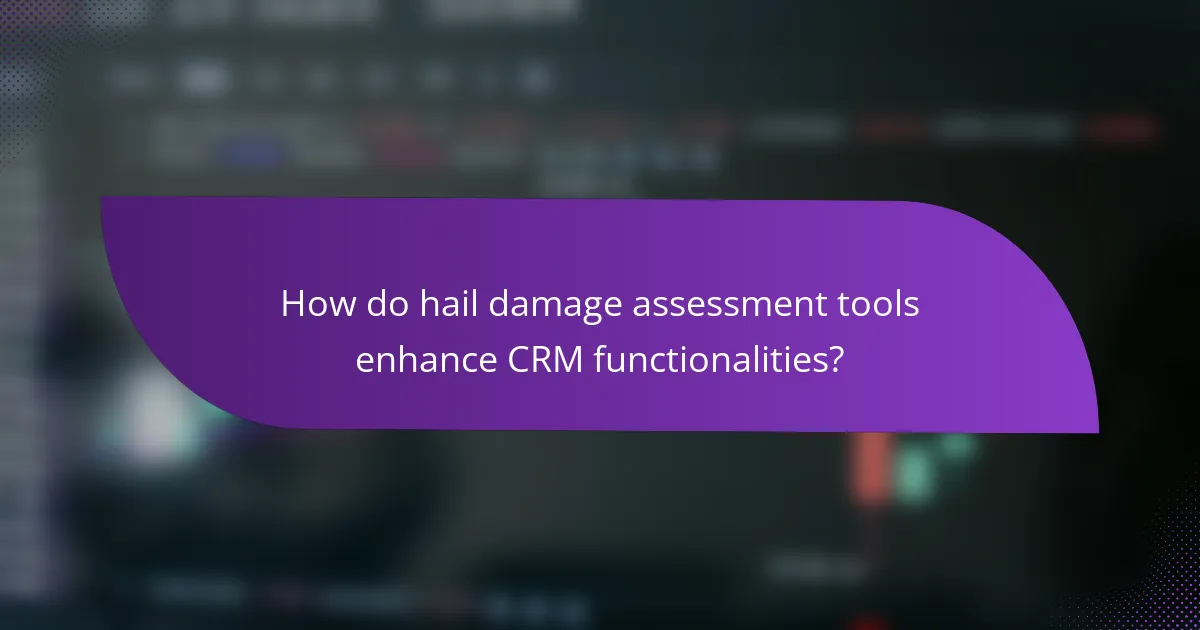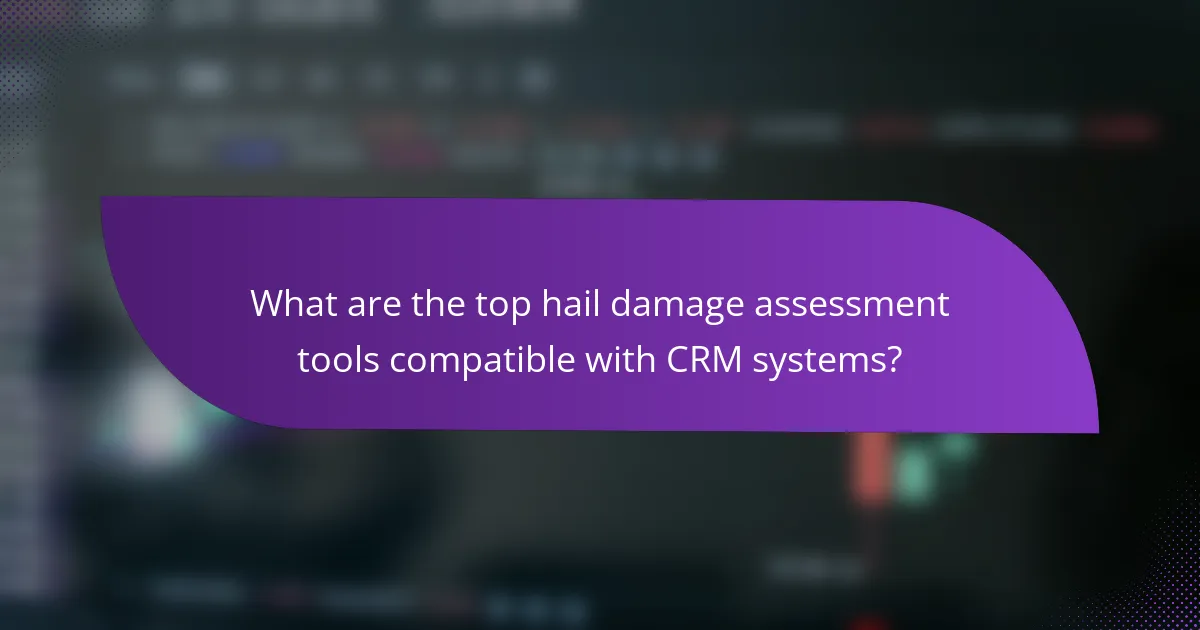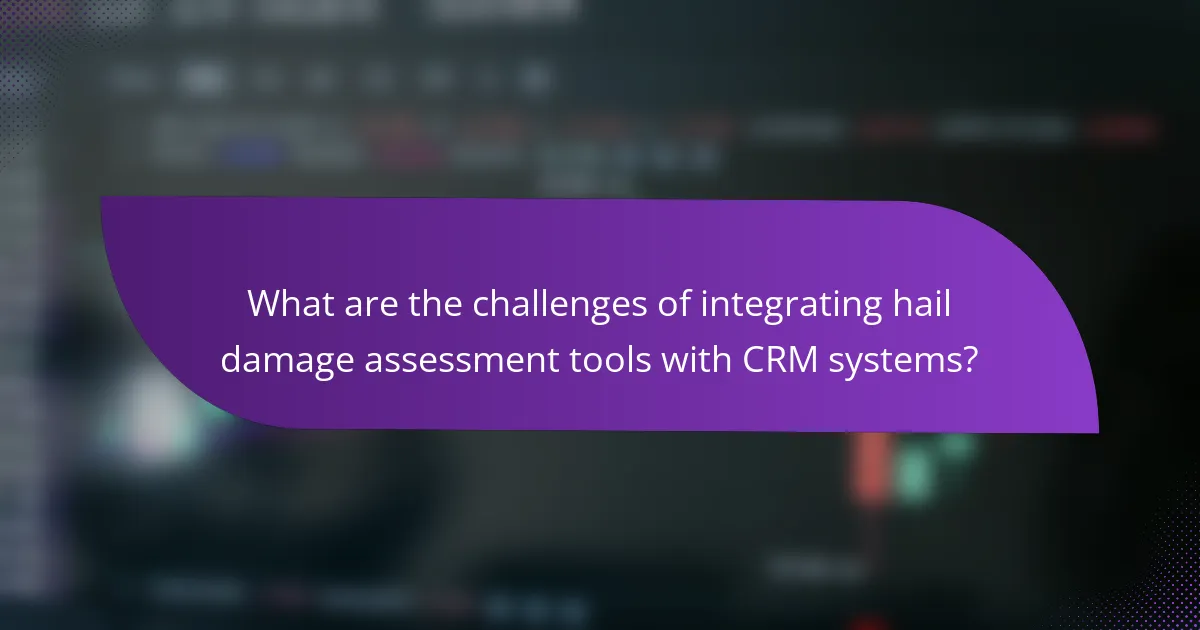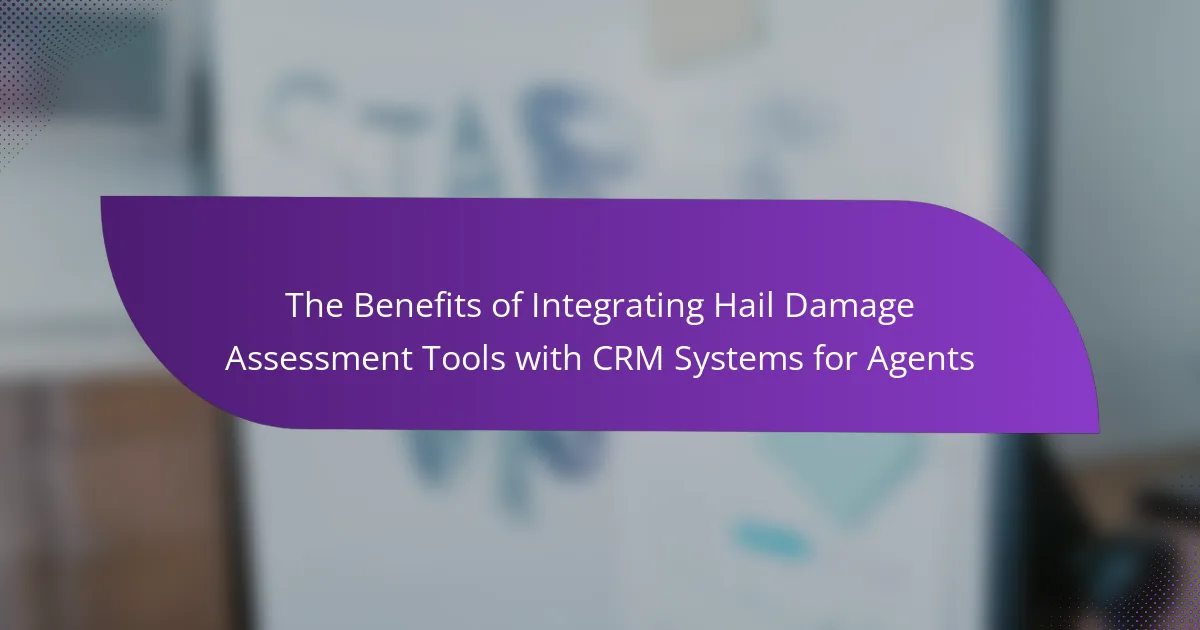Integrating hail damage assessment tools with CRM systems empowers agents by enhancing customer interactions and improving data accuracy. This synergy streamlines processes, allowing for efficient management of client information and claims, which ultimately boosts customer satisfaction and operational efficiency.

What are the benefits of integrating hail damage assessment tools with CRM systems for agents?
Integrating hail damage assessment tools with CRM systems offers agents significant advantages, including improved customer interactions, enhanced data accuracy, and streamlined processes. This integration allows for better management of client information and claims, ultimately leading to increased efficiency and customer satisfaction.
Improved customer relationship management
Integrating these tools enables agents to maintain detailed records of client interactions and hail damage assessments in one place. This centralized information helps agents respond more quickly to customer inquiries and provides a comprehensive view of each client’s situation.
For instance, having access to real-time damage reports allows agents to offer tailored advice and solutions, fostering trust and loyalty among clients. This proactive approach can lead to higher retention rates and more referrals.
Enhanced data accuracy and reporting
When hail damage assessment tools are linked to CRM systems, the accuracy of data improves significantly. Automated data entry reduces human error, ensuring that the information collected about damage assessments is reliable and up-to-date.
Moreover, accurate data allows for better reporting and analysis, enabling agents to identify trends and make informed decisions. For example, agents can track the frequency and severity of hail damage in specific areas, helping them to adjust their strategies accordingly.
Streamlined claims processing
The integration simplifies the claims process by allowing agents to access all necessary information in one system. This reduces the time spent on paperwork and communication between parties, leading to faster claim resolutions.
Agents can easily upload assessment reports and documentation directly into the CRM, which can be shared with insurance providers seamlessly. This efficiency not only benefits agents but also enhances the overall customer experience.
Increased operational efficiency
By automating routine tasks and centralizing information, agents can focus more on strategic activities rather than administrative duties. This operational efficiency translates into better service delivery and increased productivity.
For example, agents can set reminders for follow-ups or schedule assessments automatically, ensuring that no client is overlooked. This proactive management can significantly boost an agency’s performance and profitability.

How do hail damage assessment tools enhance CRM functionalities?
Hail damage assessment tools significantly enhance CRM functionalities by providing agents with accurate, real-time data that informs customer interactions and decision-making. These tools streamline processes, improve efficiency, and ultimately lead to better customer service and satisfaction.
Real-time data synchronization
Real-time data synchronization ensures that information from hail damage assessments is instantly available in the CRM system. This allows agents to access the latest details about claims, customer interactions, and property conditions without delay. For instance, when a hail damage report is generated, it can immediately update the customer’s profile, enabling agents to respond promptly.
To maximize the benefits of real-time synchronization, agents should ensure that their CRM is compatible with the hail assessment tools they use. Regularly checking for updates and integrations can help maintain seamless data flow.
Automated lead tracking
Automated lead tracking helps agents manage potential clients more effectively by automatically logging interactions and follow-ups related to hail damage claims. This feature reduces the risk of missed opportunities and ensures that no lead falls through the cracks. For example, when a new lead is generated from a hail damage inquiry, the CRM can automatically assign tasks and reminders for follow-up.
Agents should leverage automated lead tracking to prioritize high-value leads and tailor their communication strategies. Setting up specific criteria for lead scoring can help focus efforts on those most likely to convert.
Customizable reporting features
Customizable reporting features allow agents to generate tailored reports based on hail damage assessments and customer interactions. These reports can provide insights into trends, performance metrics, and areas needing improvement. For instance, an agent might create a report that highlights the number of claims processed within a specific timeframe, helping to identify bottlenecks.
To effectively utilize customizable reporting, agents should define key performance indicators (KPIs) relevant to their goals. Regularly reviewing these reports can inform strategic decisions and enhance overall operational efficiency.

What are the top hail damage assessment tools compatible with CRM systems?
Several hail damage assessment tools integrate seamlessly with CRM systems, enhancing the efficiency of agents in managing claims and customer interactions. These tools provide real-time data and analytics, enabling agents to respond quickly and accurately to hail-related incidents.
HailTrace
HailTrace is a leading tool that offers detailed hail event tracking and mapping. It provides agents with precise information about hail size, location, and timing, which is crucial for assessing damage accurately. The integration with CRM systems allows for streamlined communication and documentation, making it easier to manage client interactions.
Agents can utilize HailTrace to generate reports that can be directly linked to customer profiles in their CRM, ensuring that all relevant data is easily accessible. This capability helps in improving response times and enhancing customer satisfaction.
AccuWeather Hail Reports
AccuWeather Hail Reports deliver comprehensive weather data, including hail forecasts and historical data. This tool is particularly useful for agents who need to anticipate hail damage in specific areas. By integrating with CRM systems, agents can keep track of weather patterns and customer locations, allowing for proactive outreach.
With AccuWeather, agents can access detailed reports that can be shared with clients, helping them understand potential risks and the need for inspections. This transparency fosters trust and can lead to higher conversion rates for claims.
StormGeo
StormGeo provides advanced weather intelligence, including hail detection and predictive analytics. This tool is beneficial for agents looking to assess risk and prepare for potential claims. The integration with CRM systems allows agents to receive alerts and updates directly within their workflow, enhancing operational efficiency.
Using StormGeo, agents can analyze data trends over time, helping them to identify high-risk areas for hail damage. This insight enables targeted marketing efforts and better resource allocation when responding to claims, ultimately improving service delivery.

What criteria should agents consider when selecting a hail damage assessment tool?
Agents should prioritize integration capabilities, cost-effectiveness, and a user-friendly interface when selecting a hail damage assessment tool. These criteria ensure that the tool enhances workflow efficiency and provides value without complicating the user experience.
Integration capabilities
Integration capabilities are crucial for ensuring that the hail damage assessment tool works seamlessly with existing CRM systems. Look for tools that offer APIs or built-in connectors to facilitate data exchange, allowing for real-time updates and streamlined processes.
Consider tools that can integrate with popular CRM platforms like Salesforce or HubSpot. This compatibility can significantly reduce manual data entry and improve accuracy in client records.
Cost-effectiveness
Cost-effectiveness is a key factor in selecting a hail damage assessment tool. Evaluate both initial costs and ongoing expenses, such as subscription fees or maintenance charges. Aim for tools that provide a good balance between features and price.
Some tools may offer tiered pricing based on usage or features, which can be beneficial for agencies with varying needs. Always compare the potential return on investment by assessing how the tool can save time and improve client satisfaction.
User-friendly interface
A user-friendly interface is essential for ensuring that agents can quickly learn and effectively use the hail damage assessment tool. Look for intuitive designs that minimize the learning curve and allow for easy navigation.
Consider tools that provide training resources or customer support to assist users. A well-designed interface can enhance productivity and reduce the likelihood of errors during assessments.

How can agents maximize the use of integrated tools for better client outcomes?
Agents can enhance client outcomes by effectively utilizing integrated hail damage assessment tools within their CRM systems. This integration allows for streamlined communication, improved data accuracy, and timely responses to client needs.
Training and onboarding
Proper training and onboarding are crucial for agents to fully leverage integrated tools. Agents should receive comprehensive training on both the CRM system and the hail damage assessment tools to ensure they understand how to use them effectively. This can include hands-on workshops and access to online resources.
Consider implementing a mentorship program where experienced agents guide newcomers through the features and best practices. This approach can accelerate learning and improve overall team performance.
Regular data updates
Keeping data up-to-date is essential for accurate assessments and client interactions. Agents should establish a routine for reviewing and updating client information, hail damage reports, and other relevant data within the CRM system. Regular updates help maintain data integrity and ensure that clients receive timely and accurate information.
Utilizing automated data synchronization features can reduce manual entry errors and save time. Agents should also encourage clients to provide feedback or updates regarding their situations to keep records current.
Utilizing analytics for decision-making
Analytics play a vital role in enhancing decision-making processes for agents. By analyzing data from integrated tools, agents can identify trends in hail damage claims, client preferences, and service effectiveness. This insight allows agents to tailor their approaches to meet specific client needs.
Agents should regularly review analytics reports to inform their strategies and improve client interactions. Simple metrics, such as response times and claim resolution rates, can provide valuable insights into areas for improvement. Additionally, leveraging predictive analytics can help agents anticipate client needs and proactively address potential issues.

What are the challenges of integrating hail damage assessment tools with CRM systems?
Integrating hail damage assessment tools with CRM systems presents several challenges that can hinder efficiency and data accuracy. Key issues include data privacy concerns and technical compatibility problems that can complicate the integration process.
Data privacy concerns
Data privacy is a significant challenge when integrating hail damage assessment tools with CRM systems. These tools often handle sensitive customer information, which must comply with regulations such as GDPR or CCPA. Agents need to ensure that any data shared between systems is securely managed to protect client privacy.
To mitigate risks, agents should implement strong encryption protocols and access controls. Regular audits of data handling practices can also help identify vulnerabilities and ensure compliance with relevant privacy laws.
Technical compatibility issues
Technical compatibility issues can arise when integrating different software systems, such as hail damage assessment tools and CRM platforms. These systems may use different data formats or APIs, making seamless integration challenging. Agents must assess the technical specifications of both systems to identify potential conflicts.
To address compatibility issues, agents should consider using middleware solutions that facilitate data exchange between systems. Additionally, consulting with IT professionals can help streamline the integration process and ensure that both tools work harmoniously together.
